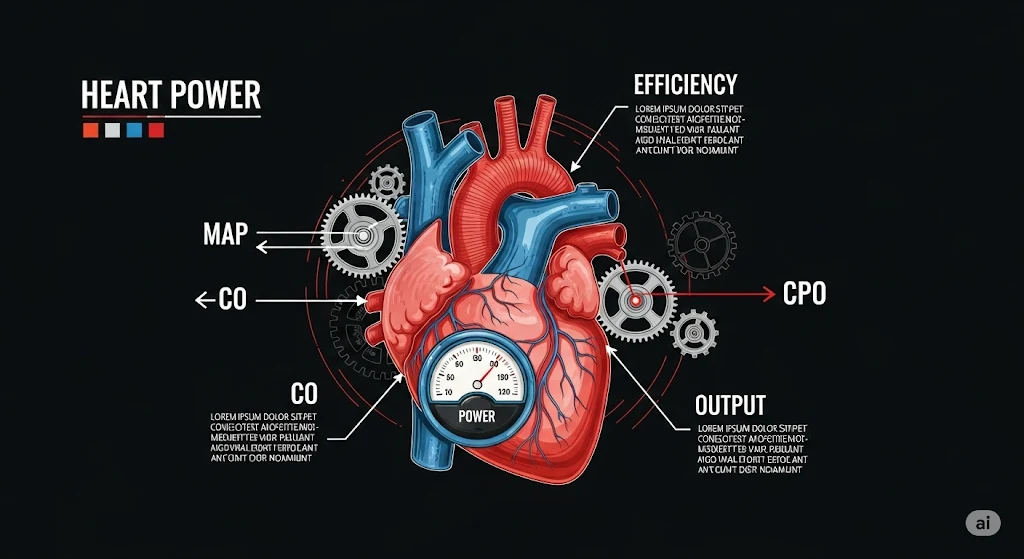
Cardiac Power Output (CPO) Calculator helps you determine a crucial hemodynamic parameter that reflects the pumping ability or hydraulic power of the heart. CPO integrates both pressure (Mean Arterial Pressure – MAP) and flow (Cardiac Output – CO) components of cardiac work. This page explains the cardiac power output formula, how to use the calculator, and its clinical relevance, especially in heart failure and shock.
Cardiac Power Output (CPO) Calculator
Results:
Cardiac Power Output: – W
Cardiac Power Index: – W/m²
Interpretation:
- Normal CPO: 0.8-1.3 W (or 4-6 kg·m/min)
- Cardiogenic shock: <0.6 W
- Severe cardiogenic shock: <0.4 W
Cardiac Power Formulas:
CPO (W) = (MAP – CVP) × CO × 0.00222
CPO (kg·m/min) = (MAP – CVP) × CO × 1
CPI = CPO / BSA (using standard 1.73 m²)
Clinical Significance:
- Measures heart’s hydraulic power generation
- Strong predictor of mortality in heart failure
- More comprehensive than cardiac output alone
What is Cardiac Power Output (CPO)?
Cardiac Power Output (CPO) is a measure of the rate at which the heart performs work. It is the hydraulic power generated by the ventricle to pump blood through the circulatory system. CPO is expressed in Watts (W).
It provides a more comprehensive assessment of cardiac function than either cardiac output or blood pressure alone because it considers both the volume of blood pumped (CO) and the pressure against which it is pumped (MAP). Understanding what cardiac output is and how MAP is derived are prerequisites.
Cardiac Power Output Formula
The formula for Cardiac Power Output is:
![]()
The constant 451 is a conversion factor to yield CPO in Watts when MAP is in mmHg and CO is in L/min. (1 mmHg = 133.322 Pa; 1 L/min = 1/60000 m3/s. Power = Pressure × Flow. So, mmHg × L/min × (133.322 Pa/mmHg) × (1 m3/s / 60000 L/min) = Watts. 133.322/60000 ≈ 1/450.01, rounded to 451 for clinical use).
Normal Cardiac Power Output Values
The normal range for Cardiac Power Output at rest in healthy adults is typically 0.9 to 1.2 Watts.
- During maximal exercise, CPO can increase significantly, up to 6-7 Watts in well-trained athletes.
- Values below 0.6 Watts are often associated with severe cardiogenic shock and poor prognosis.
Like CO, CPO can also be indexed to Body Surface Area (BSA) to get Cardiac Power Index (CPI = CPO / BSA), with normal resting values around 0.5 – 0.7 W/m2. You can use our Cardiac Index Calculator page to determine BSA.
Clinical Significance and Applications
CPO is a powerful prognostic indicator and a useful parameter for guiding therapy, especially in critical care settings dealing with heart failure and shock.
- Cardiogenic Shock: CPO is one of the strongest hemodynamic predictors of mortality in cardiogenic shock. A CPO < 0.6 W is a critical threshold. It helps quantify the severity of pump failure. Many low cardiac output conditions will result in low CPO.
- Heart Failure Management: In advanced heart failure, CPO can assess the adequacy of cardiac function and response to therapies like inotropes or mechanical circulatory support (e.g., IABP, LVAD).
- Guiding Inotrope Therapy: Titrating inotropes to achieve a target CPO (e.g., >0.6 W) can be a therapeutic goal in cardiogenic shock.
- Weaning from Mechanical Support: CPO can help determine if a patient’s native heart function is sufficient to be weaned from support devices.
- Exercise Physiology: CPO is used to assess maximal cardiac performance during stress testing.
- Prognostication: Low CPO values are consistently linked to increased mortality across various critically ill populations. The New England Journal of Medicine often publishes studies on cardiogenic shock where CPO is a key variable.
The clinical utility of CPO is emphasized in guidelines and research from organizations like the European Society of Cardiology (ESC) for management of acute heart failure and cardiogenic shock.
Factors Affecting Cardiac Power Output
Since CPO = (MAP × CO) / 451, it is influenced by all factors that affect MAP and CO:
- Factors affecting CO: Preload, afterload, contractility, heart rate. (See our detailed article on factors affecting CO).
- Factors affecting MAP: Cardiac output and systemic vascular resistance (SVR). (MAP ≈ CO × SVR, though this is a simplification).
For instance:
- Severe hypovolemia reduces preload, CO, and MAP, leading to very low CPO.
- Primary pump failure (e.g., large myocardial infarction) reduces contractility, CO, and subsequently CPO, often with compensatory increase in SVR to try and maintain MAP.
- Distributive shock (e.g., sepsis) causes vasodilation (low SVR). CO might be high initially, but if MAP falls significantly, CPO can be low or normal.
Limitations
- Requires accurate measurement of both MAP and CO. Errors in either will propagate to CPO.
- While a valuable global measure, it doesn’t pinpoint the specific component of cardiac dysfunction (e.g., preload vs. contractility issue). Other hemodynamic parameters are needed for a full picture.
For comprehensive understanding of advanced hemodynamic monitoring, including CPO, refer to specialized critical care resources and journals such as Critical Care Medicine (journal).
Explore more tools on our main calculators page and related articles on our blog, such as the clinical significance of CO monitoring.